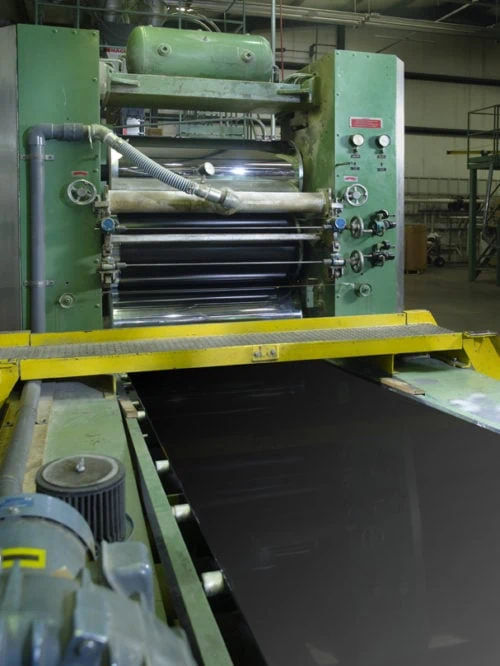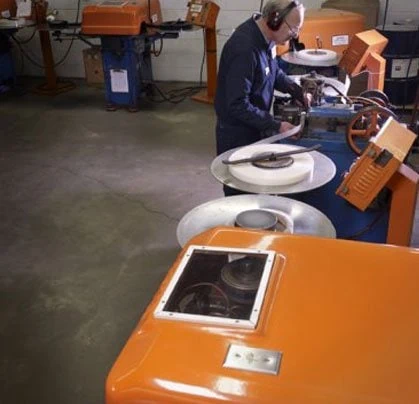Manufacturers use a variety of fabrication techniques for producing non-metal goods. Each production method comes with distinct advantages and benefits based on the design, the material, the order volume, and the goals of the project. Non-metallic stamping and plastic extrusion are two of the most popular techniques used for realizing creative and effected designs out of plastic materials. Thermoplastics and fibers offer significant flexibility during fabrication, allowing and continued alteration or processing throughout the production process. In this article, we’ll discuss what those two manufacturing processes look like and what their specific advantages are.
Request a Custom Quote for Extrusion Request a Custom Quote for StampingWhat is Plastic Extrusion?
Plastic parts are often produced through one (or a combination) of these three production methods: extrusion, blow molding, and injection molding. At its most basic, extrusion is the process of forcing a length of plastic against a die with enough pressure to force the plastic through a hole. The plastic comes out the other side in the form of the cross-sectional shape of the hole in the die. 
Technicians formulate a precise plastic compound in the form of pellets, flakes, powders, or granules. The exact material components of the compound are chosen based on the properties the final product needs to have. Once the compound is made, a machine feeds it through the hopper and extruder. A combination of heat and pressure from screws within the extruder melts the plastic into molten material that takes on the shape of the die while still molten and soft. The material maintains this shape as it cools and hardens.
What are the Key Benefits of Plastic Extrusion?
Plastic extrusion is a popular manufacturing process. While it doesn’t work for every type of plastic product or component, it’s an excellent choice for products with consistent wall thickness and which have wide or long profiles. This includes products such as:
- Washers
- Gaskets
- Insulators
- Shims
- Tags
- Spacers
- Discs
- Film
- Weather Stripping
- and other custom products…
Some of the key benefits offered by plastic extrusion include:
Speed
Extrusion is a continuous production process. The lengths of plastic can be cut and finished even as the extruder continues to produce more of the product. There are also short lead times on the process because new dies are easy to set up and extrusion produces high volumes quickly.
Design Potential
Designers can build dies with almost any cross-sectional shape or detailing to meet the product’s final design needs. Manufacturers can also produce extrusions with implanted wires and wire coatings, depending on the product’s intended usage.
Cost-Effectiveness
Extrusion is less expensive than other molding processes. The tooling costs for extrusion are far cheaper than many other fabrication processes. The speed of this production method also helps decrease the total project cost.
What is Non-Metallic Stamping?
Non-metallic stamping processes create identical products and components from sheets of material. Like extrusions, this process uses a die that will shape the final product, but that’s where the similarities end. Non-metallic stamping involves pressing the die into set sheets of non-metal material with enough force to cut through the sheet.
Multiple industries are turning to stamping production methods because the die can shape plastics and other materials within tight tolerances. However, this process requires precision, attention to detail, and well-calibrated machinery handled by experienced experts.
What are the Key Benefits of Non-Metallic Stamping?
Some of the key benefits of choosing non-metallic stamping include:
Little Material Waste
Stamping dies and machinery can stamp through material sheets with such a high degree of accuracy that little of the sheeting goes to waste. High-volume orders use larger dies that stamp out multiple identical products from a single sheet using the most efficient possible layout. Many thermoplastics and other non-metal materials can also be reformed and recycled back into sheeting for a second round of stamping, further reducing waste.
Cost-Effectiveness
The reduction in material waste helps make non-metallic stamping a cost-effective process. High speeds, short lead times, and the ability to automate production also reduce the costs associated with stamping.
Accuracy
High-quality dies can produce large volumes of products without degrading or becoming less accurate over time. Variations between stamped plastic parts tend to be much less than what is common in metal stamped parts.
Aesthetics
Non-metallic stamped parts don’t have burrs or roughened edges that require extensive finishing. Instead, the parts are visually appealing, clean, and ready for small secondary or finishing processes.
Extrusion and Stamping Applications
While both production methods have advantages, each one works best for certain applications. Extrusion processes, for example, produce a better immediate finish and can produce complex cross-sections. Non-metallic stamping and extrusion processes offer designers more dimensional options and higher volume capabilities.
Plastic extrusion is best for:
- Blow-molded items
- Films
- Insulated wire
- Sheeting
- Solid goods
Non-metallic stamping is well-suited for:
- High-volume production
- Expensive materials
- Replacing existing high-cost or slow production methods
Stamping and Extrusion Services of New Process Fibre
New Process Fibre specializes in the high-quality production of non-metallic products through both non-metallic stamping and extrusion processes. We work with each client to help them choose the manufacturing process that works best for their designs and project goals. Contact us today to learn more about our capabilities or to start your order.


